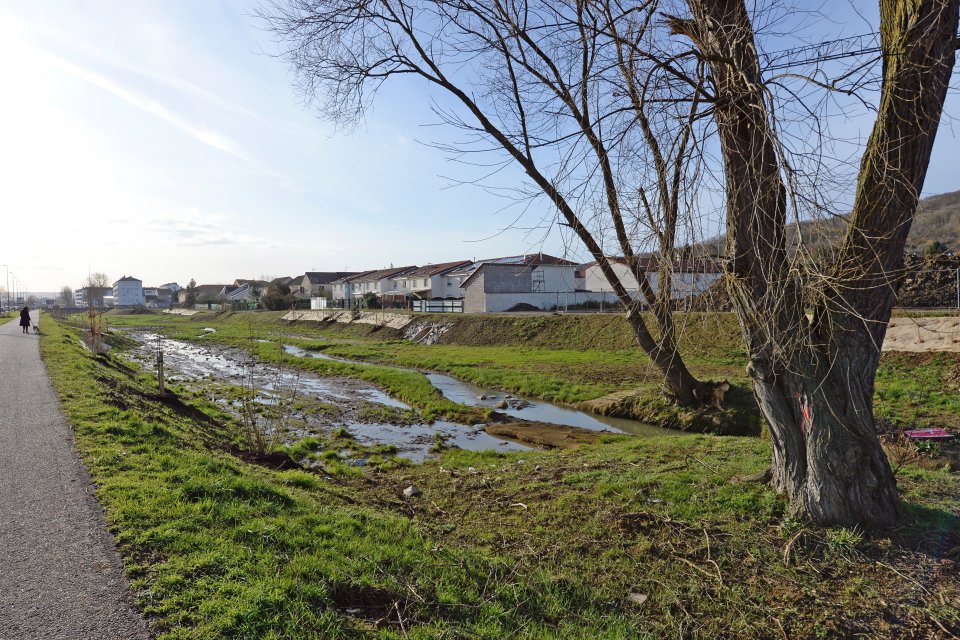
The Grémillon is a tributary of the Meurthe, about 6 km long, that drains a catchment area of more than 1200 ha. The stream is part of the urban landscape of the Nancy conurbation and flows through the communes of Pulnoy, Seichamps, Essey-lès-Nancy and Saint- Max, where it is considerably channelised. The stream has been much altered during the course of urban development, resulting in multiple problems: floods, sinking of the riverbed, partial dislodging
of water treatment infrastructure, erosion and undermining of riverbanks, loss of biological functionalities in the stretches passing through conduits. The Grémillon was identified as a “Heavily Modified Water Body” in the SDAGE for the Rhine-Meuse river basin.
• For adaptation to climate changes : combat flooding and erosion phenomena
• For biodiversity : improve riverbed-floodplain connectivity and restore biodiversity..
Works ave been decomposed in 2 phases :
• Phase 1 — sector of the Essey-lès-Nancy urban zone : restoration of the stream in the crossing of the urban zone, re-meandering, diversification of flows, removal of culverts to expose the watercourse to the open air, creation of a detention basin.
• Phase 2 — Pulnoy sector :
- In the urban zone: ecological restoration of the watercourse in the crossing of the urban zone (demolition of concrete sills and riverbanks), redevelopment and ecological restoration of the previously created Masserine reservoir.
- In the agricultural zone: restoration of the stream, re-meandering, diversification of flows, removal of culverts to expose the watercourse to the open air, development of a wetland, creation of a detention basin.
Since works ended, scientific monitoring of water quality has been implemented. In addition, work has been undertaken to reform the land tenure system between the communes and the conurbation for the sharing of maintenance of public areas. Finally, a cofferdam was constructed to improve the distribution of the stream’s flows.
BENEFITS REGARDING TARGETED ADAPTATION ISSUES
• Flooding: two storm events in 2018 proved the efficacy of the detention basins; they filled up during the course of ten-year and hundred-year rains while the works were underway.
BENEFITS FOR BIODIVERSITY
• Species: the water retention zones and helophyte plants along the stream are favourable for dragonflies & damselflies and for amphibians; bats use the stretches of riverine woodland to guide them to hunting grounds.
• Ecological continuity: the creation of water retention zones and improvement of riverbed/floodplain connectivity enhanced the spatial contiguity of the wetlands.
OTHER BENEFITS
• Living environment: improvement in landscape quality, the stream having been considered as a ditch for the departmental road before being rehabilitated. The developments carried out create meeting places for local residents, which encourages social interaction.
- Developing climate change adaptation; improving risk management and resilience
- Flood peak reduction
- Reduce flood risk
- Reduce run-off
- Carbon sequestration and storage
- Increase Biodiversity
- Changing image of the urban environment
Levers for success
• Communication : public information meetings were organised in each commune before the
start of works, and at each major step as they were being carried out. Various communication
media to inform the public (press packs, posters, information on the Grand Nancy website …) were
produced throughout the works period.
• Partnerships : numerous technical partners were involved in the project, which favoured exchanges concerning the design of developments to achieve better integration and acceptance among local residents.
• Grand Nancy Metropolitan
Authority (55%)
• Rhine-Meuse Water Agency (35 %)
• Grand-Est Region (10 %)
Total budget : 3,571,432 € exc. VAT
Stéphanie Rivat
Grand Nancy Metropolitan Authority
stephanie.rivat@grandnancy.eu

